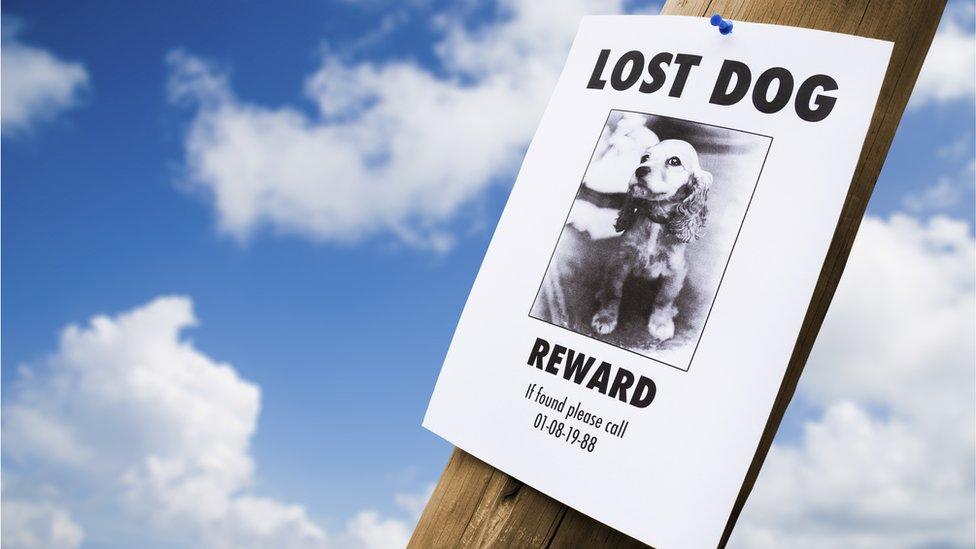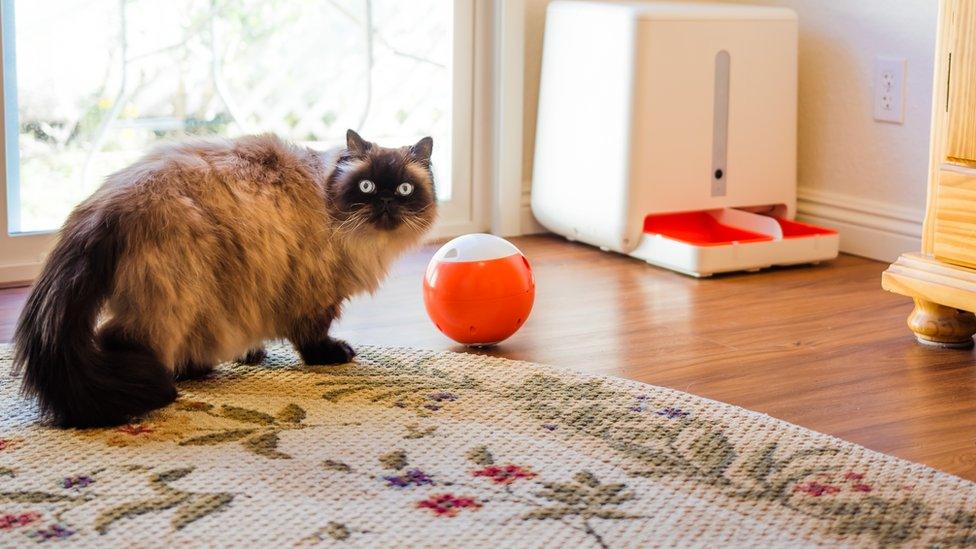Are fitness trackers for pets a fad or the future?
- Published

A smart collar helps Rhonda Vandermeer keep track of her English cocker spaniel Boz
A missing pet poster attached to a tree or lamp-post is a sad sight, as a lost moggy or pooch is a minor tragedy in any owner's life.
But luckily for Rhonda Vandermeer, a dog breeder from North Carolina, technology means she doesn't have to worry about her furry friends ever going missing.
If she ever wants to check on the whereabouts of her five-year-old English cocker spaniel Boz, she just taps on her mobile and can see his exact location.
Boz wears a smart collar with GPS tracking built in.
"He's always let off his lead and if he sees a squirrel, he's off, and I'm afraid he's going to keep running and we won't get him back," says Ms Vandermeer, who arranges for minders to look after her canine companions when she's away.
The Link AKC collar also pings her a notification if Boz has strayed beyond the boundaries she's set, which means she can quickly alert her local dog minders that he's escaped.
The collar also keeps track of the ambient temperature and how much exercise Boz has been doing.
"It's great for when I'm away and I can see how much exercise he does and what level of activity he's receiving a day," says Ms Vandermeer.
But isn't there a danger that such tech could make her a little obsessive?

Could pet trackers see an end to lost pet posters?
"At first it was like a toy and I was always checking," she admits.
And did the dog minders feel like they were being spied on?
"I explained the tools to them. I never wanted them to think I was checking up on them," she says.
A smart fitness-tracking dog collar may sound like a gadget too far, but pet owners are splashing out on all kinds of gadgets to keep track of their feline and canine companions.
Pet tech is a booming industry, with the global market predicted to reach $2.36bn (£1.84bn) by 2022, according to Grand View Research.
"People think of their pets as a part of their family and with tech adoption growing, it makes perfect sense to innovate in this area," says Abhishek Sharma, analyst at market research firm Technavio.
FitBark - one of a slew of pet tech apps hitting the market
Dan Makaveli, an academic tutor and director at Media Savvy, a digital training agency, uses FitBark, a bone-shaped collar sensor, to track his six-year-old doberman Diego's daily activity.
"He's well walked anyway but it gives you a little bit of an extra incentive to do it most days," says Mr Makaveli, who lives in Sunderland, north-east England.
"I know that by having it, it makes me determined to reach Diego's daily goal of exercise. So if he hasn't reached it and even if it's hail-stoning outside, I will take him for a run around the block."
With FitBark you can also sync your own fitness tracker with that of your dog's and compare results with other dogs of the same breed.
"My wife regularly syncs in with him and they can see where they are on the leaderboard," says Mr Makaveli.
Super-fit Diego even joined the couple when they took on Britain's Three Peaks Challenge last year.
If tracking your pet's fitness isn't enough, you can even order a 3D sculpture of it via a company such as Arty Lobster, watch it live through the Petzi Treat Cam, and organise a video conference with a vet via app-based vet practice Pawsquad.

Tiddles seems a little bemused by EasyPlay's new interactive pet gadget
And if you've ever worried about your pet getting a little bored while you're out of the house, EasyPlay could be the answer. It's a ball that works as both a pet monitor and an interactive toy.
Controlled by a smartphone, EasyPlay - which launches in July - allows owners to watch live video of their pets, talk to them, and remotely control a treats dispenser.
"EasyPlay is designed to enhance pet health and fitness in a fun and playful way, for both cats and dogs," says Adam Anderson, managing director of Gosh!, EasyPlay's parent company.
But do such devices simply make it more acceptable for owners to spend less time with their pets?
"The EasyPlay was not created to replace a personal, one-on-one relationship with your pet, instead it is a device that allows you to connect while away and improve your pet's mental wellbeing," says Mr Anderson.

If humans can have fitness trackers, why not pets?
And is all this tech really necessary, or just businesses being opportunistic?
"With the increasing awareness about pet health, owners around the world are more willing to spend on various types of tech to keep their pets safe," argues Mr Sharma.
"There has been an increase in pets being lost or stolen and hence it requires continuous monitoring to keep track of them."
But how about the animal itself? Are the gadgets always comfortable?
"Pets feel a little uncomfortable during the initial phase," says Mr Sharma. "Having said that, it is almost like getting used to a regular collar."
As for the future, given the rising adoption of the internet of things and smartphones, pet tech looks set to continue flourishing.
And for pet owners who like to keep tabs on their pets, that's just purr-fect.
Follow Technology of Business editor Matthew Wall on Twitter, external and Facebook, external